Helping Regional Communities Prepare for Drought Initiative – Community Impact Program

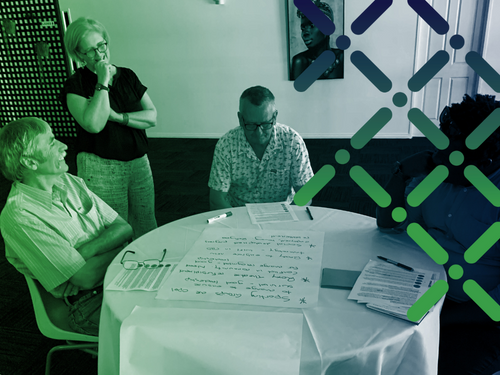
Through this initiative, with the Australian Government’s support, we’re investing in the future, enabling agriculture-dependent communities to identify and act on their drought preparedness priorities at a grassroots level.
It will do this by investing in projects that seek to strengthen social and community networking, support, engagement and wellbeing by delivering a tailored package of support that includes:

Recipient Announcements

The Community Impact Program has closed.
I have a question, who can I talk to?
Contact our Disaster Resilience & Climate Solutions team for any program related queries for the Community Impact Program.
Ph: 1800 170 020 or
Email: futuredrought@frrr.org.au
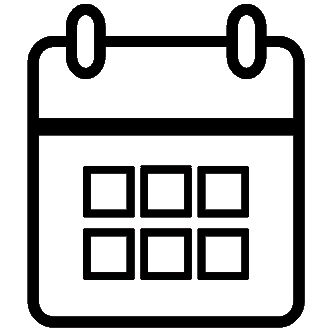
Key Dates and Resources
What are the program objectives?
The Community Impact Program is designed to support community members and not-for-profit organisations in remote, rural and regional Australia to drive local action that helps prepare for drought. It is part of the Australian Government’s commitment through the Future Drought Fund to support Australian agricultural communities to build drought resilience.
These Guidelines provide information about the Community Impact Program, which has two parts – the Community Impact Grants, and Community Leadership Activities that are available in locations listed in this document. Applicants may apply for both a grant and funded leadership activities through a multi-stage application process.
The Community Impact Grants will fund projects, events, initiatives, training, capability building and small-scale community infrastructure projects that assist local people and communities to prepare for future droughts through improved capability, and networks.
The Program is designed to support a wide range of locally relevant initiatives that will result in the following outcomes:
Is this grant available in my area?
The Community Impact Program is available in 35 defined regions across remote, rural and regional Australia to enhance drought preparedness.
A national call in all 35 regions has been completed, and we’ve now moved into the program delivery phase.
Please review the list of regions and LGAs that are supported by this program.
How much funding is available? Are there priority areas?
The program will provide 35 grants – one for each region – with a maximum total value of $12.1 million, to be implemented over a two year period.
The grant size for each region will be negotiated as part of the multi-stage application process and may range between $200,000 and $500,000 (see below). Should total demand for funds exceed the grant funding available, grant values will be reduced proportionately.
While one collaborative proposal per region will be accepted, the funds may be disseminated via multiple funding agreements to reduce the risk and administrative burden on the lead applicant and ensure that activities and outcomes have wide engagement and benefits across the region. Any such arrangements would be considered as part of the application process. Funding agreements will only be entered into with not-for-profit organisations.
Priorities for program investment that will be considered when selecting successful applicants include:
Note: All funding is targeted to the declared regions and LGAs listed in this document.
What can be funded?
Eligible activities must contribute to the outcomes of the Community Impact Program and may include, but are not limited to:
What can’t be funded?
There are a range of areas that we cannot fund through this program, including:
Please contact us to discuss your eligibility prior to lodging an application if you are unsure.
Is my organisation eligible?
Applications are sought from locally based not-for-profit organisations that:
Applications that include locally based community organisations that have participated in the Future Drought Fund’s Regional Drought Resilience Planning, where applicable, will be prioritised. Where Regional Drought Resilience Planning is not yet underway, applicants will not be unduly penalised.
Lead applicants may submit a maximum of one application for a Community Impact Grant.
While proposals should reflect collaboration from multiple organisations, the primary applicant, known as a Community Partner Lead Organisation, must be a single legal not-for-profit entity.
One grant allocation will be provided for each region. If more than one group of local community organisations applies in each region, FRRR may work with applicants to explore the potential to expand the partnership opportunities under the strongest application.
To apply, your organisation must meet the following criteria:
Please note, you will be considered ineligible if the:
Associated Support – Community Leadership Activities
In addition to the Community Impact Grants, ARLF is offering a selection of optional and complementary Leadership Activities at no cost to the applicant. The Leadership Activities are designed to strengthen the leadership capabilities of communities to build individual and community drought resilience. They are underpinned in their design by the concepts of adaptive leadership, resilience, and network leadership.
During the application process, organisations will be invited to nominate an indication of the community’s two preferred Leadership Activities and the timeframe for delivery. Information about ARLF and each Leadership Activity is included in the Guidelines, or you can download a copy of the prospectus.
The ARLF will partner with community organisations to confirm and plan their selected Leadership Activities throughout the application and assessment process.
Impact Grants Program: Definitions and Frequently Asked Questions
Please read the information below to help you learn more about the program.
If you have any further questions, please contact Nina O’Brien, Disaster Resilience & Climate Solutions Lead, by emailing futuredrought@frrr.org.au or free call 1800 170 020.
Definitions
1 Derived from https://www.macquariedictionary.com.au/features/word/search/?search_word_type=Dictionary&word=strategy, retrieved 2022
2 Department of Agriculture, Water & Environment (2022) National Agricultural Innovation Agenda: Digital foundations for agriculture strategy (awe.gov.au). p.37
Frequently Asked Questions (FAQs)
1. How did the Initiative come about?
The Helping Regional Communities Prepare for Drought Initiative combines and builds on the previous Networks to Build Drought Resilience program (delivered by FRRR) and the Drought Resilience Leaders program (delivered by the Australian Rural Leadership Foundation – ARLF), so that together we can deliver a more effective and targeted approach. Thanks to funding from the Australian Government’s Future Drought Fund, through this Initiative $29.6 million will be invested over three years to scale up and expand the reach of our community support in regional areas. By investing at a larger scale, the program aims to shift the dial on community drought preparedness in those regions and nationally.
2. What’s the program’s purpose?
The climate is changing and the frequency and severity of dry periods and droughts in the future is predicted to increase. Many individual farmers are taking proactive steps to prepare and respond, and it is important that the communities that they rely on also have opportunities to come together and do the same.
From our years working on the ground, we know that local people are best placed to know what they need. Having communities actively engaged in preparing for drought will help people engage with risk and take an informed approach to plan.
Through this Initiative, with the Australian Government’s support, we’re investing in the future, enabling agriculture-dependent communities to identify and act on their drought preparedness priorities at a grassroots level.
We will do this by investing in projects that seek to strengthen social and community networking, support, engagement and wellbeing by delivering a tailored package of support that includes the Community Impact Program, which offers a range of grants and community leadership activities. This program sits alongside four other elements of the Initiative.
3. What are the five elements of the Helping Regional Communities Prepare for Drought Initiative?
- Community Impact Program: Grants between $200,000 and $500,000 provided by FRRR, plus on the ground support including a range of leadership development activities provided for free to Impact Grant recipients by the Australian Rural Leadership Foundation (ARLF).
- Expertise Pool: Access to specialist expertise to activate drought resilience initiatives (curated by FRRR).
- Small Network Grants: Up to $20,000 to develop and deliver one-off events or initiatives (led by FRRR).
- National Mentoring Program: Bringing together those who want to contribute to their community’s drought resilience with experienced mentors (led by ARLF).
- National Learning Network: Connecting individuals and organisations committed to building drought resilience, so they can learn from and support one another (led by ARLF).
4. What other support is available as part of this Initiative?
FRRR and ARLF will bring our years of experience in working with rural communities to support local groups to develop, design and implement their project ideas. In addition to access to FRRR and ARLF staff, there will be local support on the ground, together with access to each of the elements of the program, including the expertise pool, mentoring and networking.
5. Who is running the Leadership Development Activities?
The Leadership Development Activities will be delivered by the Australian Rural Leadership Foundation (ARLF). As Australia’s pre-eminent provider of rural leadership development, ARLF has proudly delivered transformational leadership development for 30 years. With 2,000 alumni working across industry, NGOs, corporate, government, community and family farms, these leaders are critical to the success of prosperous agriculture-dependent communities.
The ARLF exists for the greater good of rural, regional and remote Australia. Their vision is an Australia where regional communities thrive and strengthen the nation. They build the capacity of individuals and groups to act beyond themselves, to create action and change in their organisation, industry, or sector and, in their community. The ARLF develops and promotes leadership through its experiential leadership programs conducted across Australia and the Indo-Pacific region since 1992.
The ARLF is the only leadership development organisation with a national footprint and a focus on remote, rural and regional Australia. They are an independent not-for-profit based in Canberra, with staff and associates across the nation. ARLF is supported by government, businesses, and the community in realising its purpose to foster and exercise leadership for positive impact.
6. What does drought preparedness mean?
Drought preparedness is the ability to adapt, reorganise or transform in response to changing temperature, increasing variability and scarcity of rainfall and changed seasonality of rainfall, for improved economic, environmental and social wellbeing.
The Future Drought Fund’s vision is an innovative and profitable farming sector, a sustainable natural environment and adaptable rural, regional and remote communities — all with increased resilience to the impacts of drought and climate change.
7. Why is drought preparedness so important?
It’s clear that the climate is changing and the frequency and severity of dry periods and droughts in the future is predicted to increase. Many individual farmers are taking proactive steps to prepare and respond, and it is important that the communities that they rely on also have opportunities to come together and do the same.
Having communities actively engaged in preparing for drought will help people engage with risk and take an informed approach to plan.
Drought can create difficulties in maintaining the social fabric or social capital of rural and regional Australia, which may threaten the viability of some rural communities. Despite sometimes sharing similar challenges, Australia’s rural and regional communities differ greatly — socio-economically, climatically, geographically, economically, and in their proximity to large regional centres.
Social capital is built on social networks of trust, mutual support and understanding. When people are part of social networks, they are more involved in community life. Community and economic diversity is an important factor in increasing resilience. Drought can reduce people’s ability to work together for the benefit of the whole community. For example, when people experience stressors impacting on their individual or family circumstances, they may have reduced capacity to engage in social and business networks. This may also reduce their capacity to empathise with their peers and learn innovative ways to manage through drought. It also reduces capacity to engage in community projects, sporting activities or voluntary work, all of which can help keep rural communities vibrant, prosperous and contribute to ongoing resilience against various shocks.
From our years working on the ground, we know that local people are best placed to know what they need. Through this program, with the Australian Government’s support, we’re investing in the future, enabling agriculture-dependent communities to identify and act on their drought preparedness priorities at a grassroots level.
8. What about other natural disasters?
FRRR provides funding and capacity building support at the hyper-local level. We have reach, relationships, networks, and know-how to align funding, big and small, to community-led solutions that build resilience and long-term viability and vitality of smaller remote, rural, and regional communities across Australia.
Please visit Find Funding Now to find other funding opportunities, including relief for other natural disasters.
9. What are the criteria for being agriculture-dependent / what does it mean?
Agriculture-dependent communities refers to remote, rural and regional communities with a high economic dependency on agriculture and related industries.
10. Does my area have to be currently experiencing or recovering from drought?
No. Your community just needs to be in one of the areas identified as eligible to apply on the map or in the Shires listed in the guidelines. This program is about preparing for drought, and is designed to build strong social connectedness, strengthen social capital, and support transformative activities that enable regional communities to be more prepared for, and resilient to, the impacts of drought.
11. Who’s funding the program?
This program is supported by FRRR and the Australian Rural Leadership Foundation, through funding from the Australian Government’s Future Drought Fund.
12. Are Arts projects eligible?
Yes, we encourage applications for Arts projects. Applicants must address how the proposed project will contribute to the program objectives.
13. Can Councils apply for funding?
Councils can apply for funding provided the project demonstrates clear community benefit and aligns with the Future Drought Fund program objectives.
14. What is the application process?
This is a multi-stage application process:
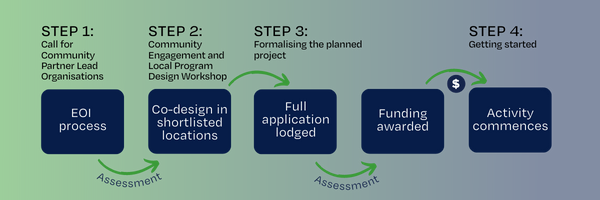
As part of the assessment process applicants may be interviewed by FRRR or our Future Drought Fund partners. As outlined here, those selected to move forward will then participate in a locally-based co-design process, which will help flesh out the project plan.
15. Do you have to be a registered organisation?
The applicant organisation must be a not-for-profit organisation with an ABN or Incorporation Certificate. Organisations with or without DGR-1 endorsement are eligible. The proposed project must be for charitable purposes and offer clear public benefit.
16. What is a Community Partner Lead Organisation?
A Community Partner Lead Organisation is a locally based not-for-profit organisations that will:
17. What if I have a good idea but don’t belong to an organisation?
Contact us for a chat. We can put you in touch with the relevant partners in your local region so you can get involved. Many hands make light work.
18. What if the organisation I’m involved with can’t be the Lead Organisation in our region?
Contact us for a chat. We can put you in touch with the other relevant partners in your local region and devise a way in which you can get involved where appropriate.
19. What is the process to receive funds?
FRRR staff assess each application on its merit against each of the assessment criteria and compare it to other applications. Applications are then shortlisted for deliberation by the Future Drought Fund Program Advisory Committee, who make recommendations to the FRRR Board. The Program Advisory Committee membership represents a range of industry and program partners including representatives from ARLF and DAFF. The FRRR Board makes the final determination about which projects are funded, to ensure it meets their contractual obligations to the Australian Government’s Department of Agriculture, Fisheries and Forestry, and ultimately that the projects are in line with the Future Drought Fund Act 2019.
20. When can I start my project?
A grantee must not commence work on the project activities before a grant agreement is executed with FRRR. Payment will not be back-dated for activities that commenced before the execution of the grant agreement, and no payments will be made unless a grant agreement has been executed.
21. Where can I find out more information?
Please ensure that you read the information on this page carefully and in the Guidelines. If you still have questions or are unsure about something, contact the Disaster Resilience & Climate Solutions Lead, Nina O’Brien via email at futuredrought@frrr.org.au, or free call 1800 170 020.
22. My LGA is not listed, or we would like to deliver our project in a different area to those listed. Am I eligible to apply?
Please call us to discuss your ideas before you apply. The program is designed to be community-led, so we welcome your feedback and thoughts on the definition of the region.
23. I want to deliver a project across multiple regions or states. Is this eligible?
We ask that you please call us to discuss this before you apply. Call 1800 170 020.
24. We need money for an infrastructure project. Can we use the money just for this?
No, this program is designed to build capacity of people and communities, so while you can apply for small-scale infrastructure or equipment, it must not exceed 10% of your total budget. You can head to the Find Funding section of this website to see if there are other programs you might be eligible to apply for.
“Lessons learnt from previous drought shared amongst the network are of such high importance, and this funding has created a platform for us to be able to do that across our community: making brave decisions to pick up your commodity and move it to a more safer place off your farm where someone else looks after it; for fear of hanging onto it in a drought, would devastatingly mean losing it all together. It is important to share real & raw drought stories like this within our drought preparedness forums, as it allows others insight, energy and a safe educational space other to think outside the box.”
Grant recipient from Networks to Build Drought Resilience program
Inspiration – Past projects
Explore some of the projects we’ve previously funded through the Networks to Build Drought Resilience program to see how other organisations have helped their community thrive.
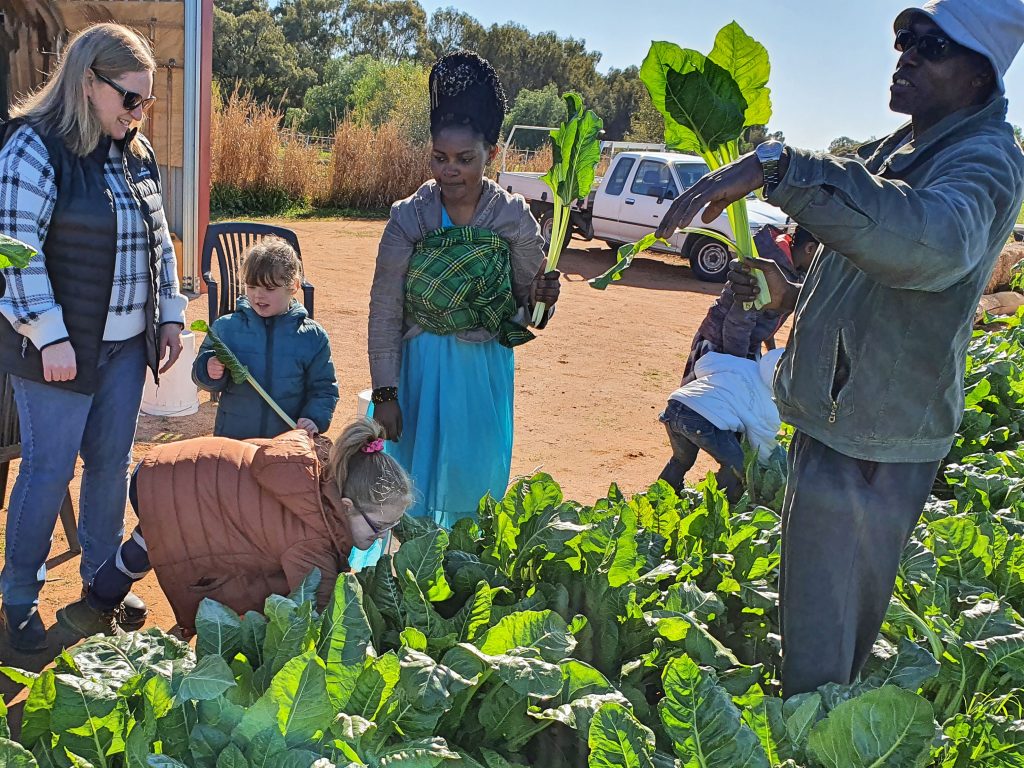
Food Next Door Co-op strengthens connections in Mildura
Through a short training course and discussion forums with Young Farmer groups and local hobby farmers, this project is building drought resilience through increasing knowledge and understanding of the risks posed by drought and climate change at a local level. The training course and forums support information sharing about climate change impacts on food production and strengthening resilience for local farms, increasing the region’s capacity to prepare for the impacts of drought.
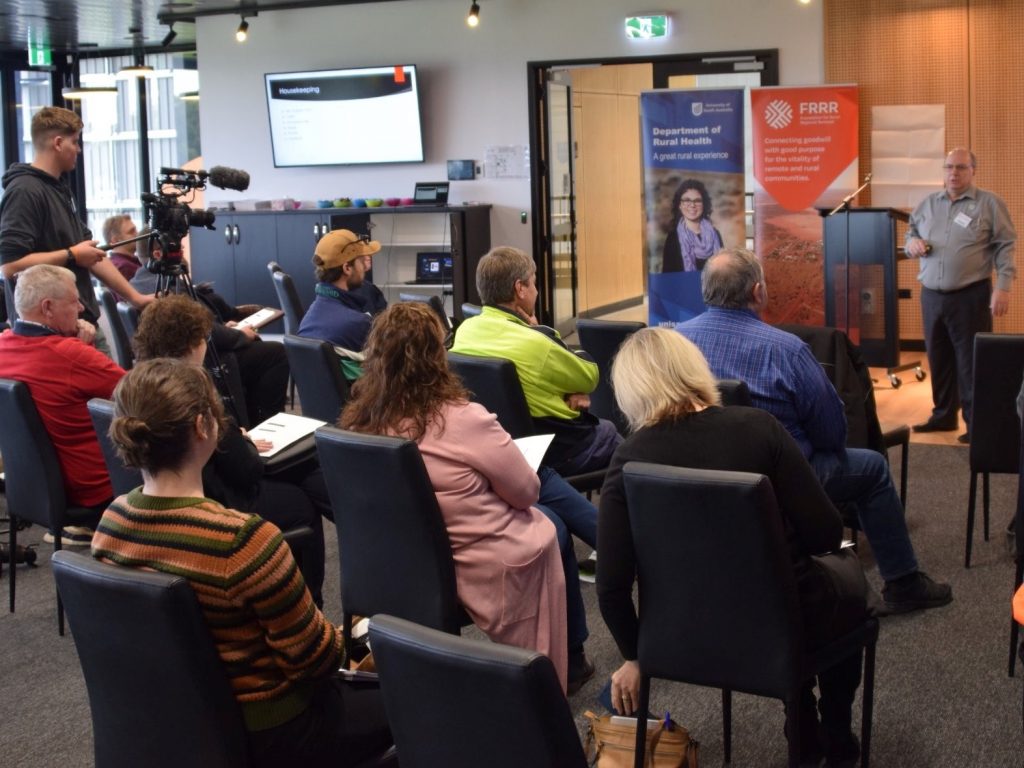
Vocal Locals strengthening wellbeing and support
The University of South Australia is assisting the Loxton community to support one another to improve wellbeing and strengthen networks to prepare for tough times ahead. They’ve run a community-wide mental health workshop, launched a campaign online and across neighbourhoods where locals share their personal journey, plus hosted workshops to strengthen connections. All these activities upskill and support others in the agriculture-dependent community.
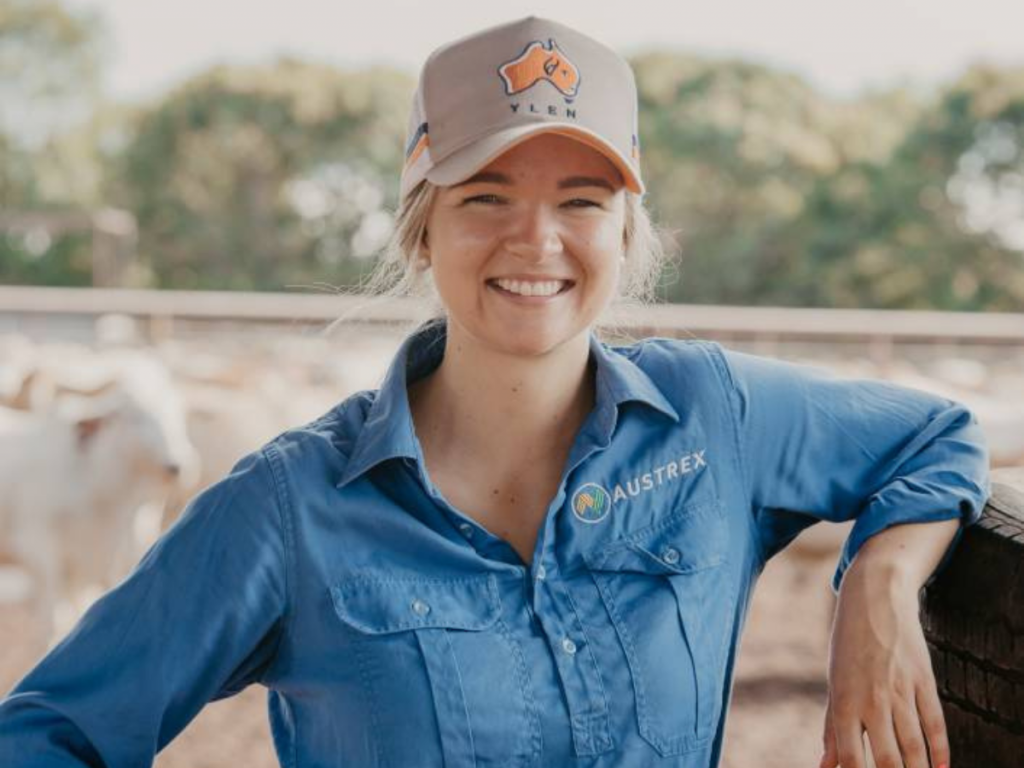
Future-proofing the livestock industry
NT based organisation Young Livestock Exporters Network (YLEN) is using a $45,867 grant to run the YLEN Leadership Program: Future-Proofing the Livestock Industry.
This project creates opportunities through two training events, a leadership program and stockperson course, designed to bring rural youth together to discuss the impacts of difficult times, including drought.
Photo: Farm Online

